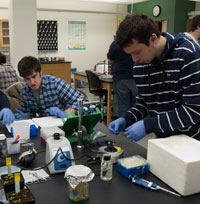About the course
What will we do? (course structure)
The classroom component of the course is based on Powerpoint lectures; general topics covered are mentioned above. Opportunities for dialogue and discussion also exist. One component of the course judged to be enjoyable and effective by previous students is what I refer to as Problem Solving. In select lecture and laboratory periods you will work in groups to address problems or case studies related to the preceding lecture material. This is intended to help you understand and apply the material you are learning. Other questions will be provided to serve as preparation for exams.
The laboratory component of this course is focused on introducing you to experimental methods and techniques used in modern biochemical research, through both discussion and application (hands-on). During the first half of the semester in Spring 09, laboratory experiments focused on analysis of DNA. Experimental methods included nuclease digestion, agarose gel electrophoresis, and polymerase chain reaction (PCR); these lab modules are designed to serve as a “next step” from exercises you may have performed in introductory biology courses. The second half of the semester focused on working with proteins, including protein purification by affinity chromatography, determination of protein concentration in solution, use of SDS-PAGE to analyze proteins, and assays for enzyme activity and kinetics.
Students kept lab notebooks as well as engaged in exercises utilizing primary literature and bioinformatics databases as part of the Spring 2009 course.
If you have any questions about the class, please don’t hesitate to speak with me for more information.
Amy T. Hark
Assistant Professor of Biology and Co-Director of Biochemistry major
New Science 225
484-664-3747
